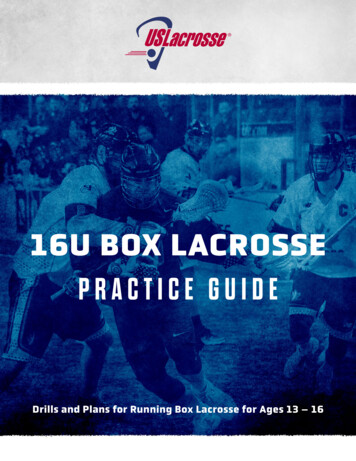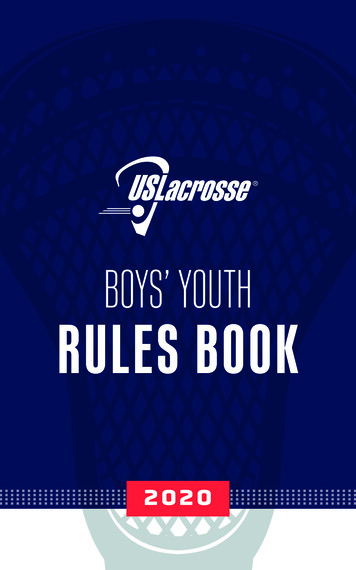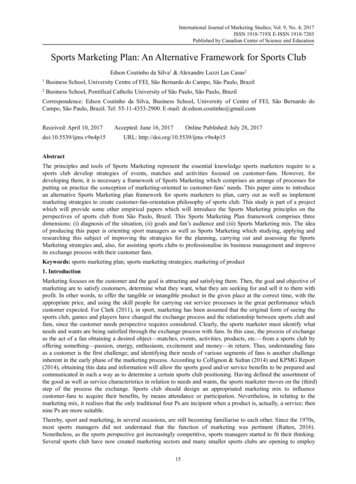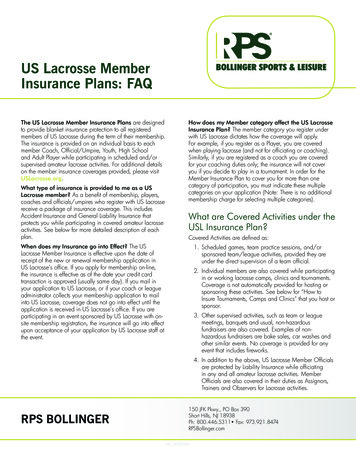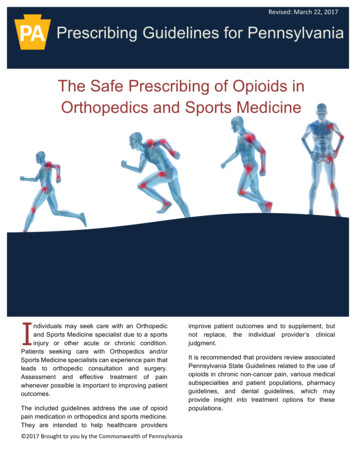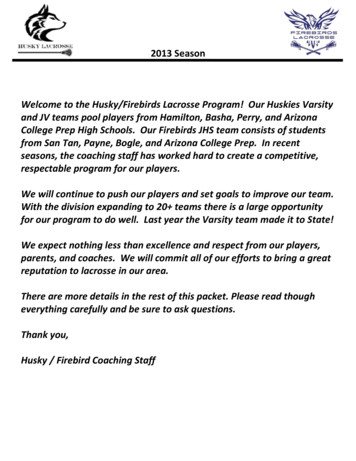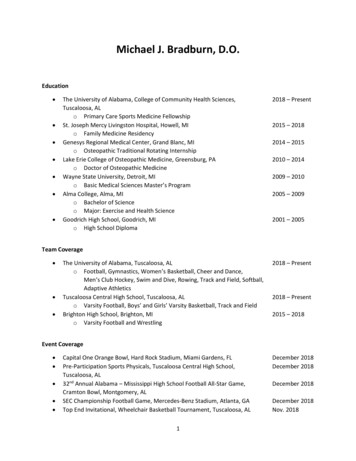
Transcription
LACROSSE SPORTS MEDICINETaking Care of America’s FastestGrowing GameRichard Hinton, MD, MPHMedical Director / Fellowship Director, MedStar Sports MedicineExecutive Member, US Lacrosse Sports Science and Safety CommitteeBaltimore, Marylandrichard.hinton@medstar.net ( 410 ) 554 - 2161
GOALS AND OBJECTIVES Appreciate priority health and safety issues facing the game oflacrosse Understand the role of US Lacrosse, the national governing body formen's women's, and youth lacrosse promoting in health and safety. Understand the public health approach to research which has beenutilized by the US Lacrosse and MedStar Sports Medicine toinvestigate and prioritize lacrosse medical conditions Appreciate the significant differences in men's and women's lacrossewith regard to health and safety. Appreciate the position of lacrosse as America’s fastest growing teamsports and some consequences and opportunities associated with thisrapid growth.
LACROSSE SPORTS MEDICINE Growing body of sportspecific knowledge Multidisciplinary Real world impact
MEDSTAR HEALTH / SPORTS MEDICINE Largest, ComprehensiveSports Medicine Program inMid Atlantic Graduate Medical EducationResearch in Sports Medicine Teams and OrganizationalPartnerships
MEDSTAR: LACROSSE SPORTS MEDICINE
LACROSSE SPORTS MEDICINE: A PARTNERSHIP US LACROSSE: Thenational governing bodyfor men’s. women’s, andyouth lacrosse Full Circle of Activity Public Health Approachto Health and Safety
US LACROSSE Unified administrative bodyestablished in 1998 Baltimore based, but national scope 65 national chapters 450,000 members Exponential growth Current 18 million campaign fornew national headquarters 1million toward health andsafety programs 1 million toward expanding playopportunities Proactive in health and safety Mission: Positive games experience
SPORTING SUCCESS IN AMERICA Focus on the Top of theParticipation Pyramid Multiple SecondaryGain Issues Victory at OthersExpense Professional Play thePicture of Success
US LACROSSE: SPORTING SUCCESS Positive GamesExperience for the Base ofthe Pyramid Honoring the Game Playing the Sport to LearnLife’s Lessons Health and Safety aPriority Can this Model Succeed ?
BACKGROUND Oldest and fastest growingteam sport in America Unique men’s, women’sand youth games Played by all age groups Combination of speed,stick, ball, and contactmake for a unique set ofinjury mechanisms, types,and preventive efforts
EARLY MODERN GAME 1800’s: French Pioneers 1856: Montreal Lacrosse Club 1867: George Beers: RulesStandardization 1877: New York University FirstU.S, College Team 1930s: 12 10 Players, ReducedField Size, Protective Equipment,60 minute games 4 quarters
EARLY MODERN GAME 1904 – First Olympic play in St. Louis Games (‘08, ‘28, ’32 & ‘48)
MODERN GAME Protective head gearfirst required in men’slacrosse in 1948 NOCSAEmanufacturingstandard for men’slacrosse helmets 1986
MODERN GAME
EARLY MODERN GAME 1890s: St. Leonard’sSchool in Scotland 1926: Bryn Mawr Schoolin Baltimore 1931: U.S, Women’sLacrosse Association Rules: MaintainedLower Contact, LessStructure than Men’sGame
MODERN GAME
US LACROSSESports Science and Safety Committee 16 Member Multidisciplinary Committee LiaisonsCommittee NCAA Formed 1999: A priority for NFHSUS Lacrosse NATA Primary Care Rules Committees Surgical Subspecialties Insurance and Risk EpidemiologistsManagement Health Policy Other Affiliations Allied Health MedStar Research AOSSM / STOP
US LACROSSESports Science and Safety Committee “To utilize and grow thebody of lacrosse healthand safety knowledge toobjectively adviseUS Lacrosse and thelacrosse community onfactors to enhance thesafety and quality ofexperience in the sport atall levels of play” Review available Lacrosse specificliterature Survey of stakeholders Initial assessment of priority healthand safety issues Build research foundation anddevelop appropriate partnerships Conduct and facilitate research Comprehensive, Public HealthApproach with Real WorldApplications
Step 1The MedStarAdvanced Model for Sports MedicineResearchRisk FactorIdentificatonInjury & DiseaseSurveillanceEstablish Etiology andMechanisms ofSports InjuryProblem IdentificationEstablish Extent ofInjury Problem(Data Collection)Step 5Implementation,Feedback andAssessmentFull ScaleImplementation &EffectivenessStep 2Step 3Step 4Develop Intervention/Potential SolutionsAssess Effectivenessin controlledenvironmentDevelop, Introduce &Revise PreventiveMeasuresFeedback
PUBLIC HEALTH APPROACH: STEP 1 /2Injury & DiseaseSurveillanceProblem IdentificationEstablish Extent ofInjury Problem(Data Collection)··Critical Pre-Cursor to all other stepsChallenges:§ Standardized Sports Injury and Exposure definition§ Statistical Methods to assess spatial and temporaltrends in injury incidenceBasic, Descriptive Epidemiology,the “ Who, What, Where, When and How “
Sports Injury Surveillance SystemsSystemAdministratorProsConsExample studyNCAA InjurySurveillanceSystem (ISS)Datalys Center Web-based High capture rate National sample Variability in datacoding(?) Limited # ofparticipatingcollegesValidity of SoccerInjury Data inNCAA (2011)Injury Treatment &Tracking System(ITTS)Fairfax County(VA) PublicSchools Daily electroniccapture of 25 highschools & 27 sports Includes time-lossand no time lossinjuries Representative ofa single geographicarea/schooldistrictTrends inconcussionincidence in highschool sports(2011)ReportingInformation Online(RIO)NationwideChildren’sHospital Web-based 100 participatinghigh schools with AT National sample of12 sports Variability in datacoding(?)Sex Differences inConcussionSymptoms of HighSchool Athletes(2011)National Center forCatastrophic SportInjury ResearchUniversity ofNorth Carolinaat Chapel Hill Death andpermanent disabilitysports injury data thatinvolve brain and/ orspinal cord injuries Based on reportsof catastrophic/fatal injuriesCatastrophicFootball InjuriesAnnual Report(2011)23Injury Surveillance Systems: Hinton, RY Sports Medicine Update, AOSSM Jan / Feb 2012
INJURY RATES: NCAAMENS AND WOMENSLACROSSE Men's: Upper 1/3 ½ Football 2 x Women Game 3.5 x Greater thanPractice Women's: Lower 1/2 ½ Soccer Game 2.5 x Greater thanPracticeFebruary 18, 201524
Fairfax Co. Virginia: 2 ATCs in Each Public High School Data Entry Part of Job Description: High Quality, Real Time SIMS Injury System: Prospective, Computerized Injury Tracking System,1997 – 99 ( On Going ) 25 High School: Boys and Girls Lacrosse Boys (combined seasons) 2476 Athletes 136,180 Athletic Exposures Girls (combined seasons) 1711 Athletes 85,555 Athletic Exposures
SCHOLASTIC LACROSSE INJURIES: BOYS
SCHOLASTIC LACROSSE INJURIES: GIRLS
Head, Face, and Eye Injuries in Scholastic andCollegiate Lacrosse: A 4 Year Prospective Study:Lincoln, A, Hinton, RY et al AJSM 2007,35,207 - 15 AOSSM Keystone, CO July 16, 2005: NCAA ResearchAward Most Comprehensive View of Head, Face, and Eye Injuriesin Lacrosse Injuries Prospective, Multiyear, Well Defined, Quality Data Entry Information on Injury Type, Location, Severity, Mechanismand Risk Factors based on Gender, Player Activity, GameActivity, Position Specific to Head, Face, and Eye Injuries Scholastic and Collegiate Players: Fairfax Co., Va andNCAA Data
GENDER SPECIFIC INJURY RATES Overall Head/Face/Eye InjuryRates Significantly Higher forWomen vs. Men Scholastic RR 1.42, 95 % CI 1.09 – 1.86 Collegiate RR 1.61, 95 % CI 1.32 – 1.97
GENDER SPECIFIC INJURYInjury Type and Percentage Men: Scholastic Concussion 73 % Contusion 12 % Fracture 4 % Men: Collegiate Concussion 83 % Contusion 12 % Fracture % Women: Scholastic Concussion 40 % Contusion 33 % Fracture 14 % Women: Collegiate Concussion 43 % Contusion 23 % Fracture 17 %
CONCUSSIONMechanism, Number, Incidence Rate Men, Scholastic Body to Body: 33, 0.11 Stick to Body: 14, 0.05 Body to Ground: 6, 0.02 Men, Collegiate Body to Body: 101, 0.27 Ball to Body: 11, 0.03 Stick to Body: 8, 0.02 Women, Scholastic Stick to Body: 22, 0.11 Body to Body: 6, 0.03 Body to Ground: 5, 0.02 Women, Collegiate Stick to Body: 55, 0.12 Ball to Body: 45, 0.10 Body to Body: 20, 0.04
Figure 2. Concussions and player activity in collegiate lacrosse, NCAA, 2000-200360WomenMen495042Frequency (n)40373331302320161110770ShotPassBall HandlingLoose BallOther
American Journal of Sports Medicine, 2012 40: 756 - 62
American Journal of Sports Medicine, 2013, 41: 756 - 61
MECHANISM OF CONCUSSION IN SCHOLASTIC LACROSSEInjury CharacteristicsBoysGirlsVarsity22 (65%)14 (100%)Junior varsity12 (35%)032 (94%)1 (7%)Stick (unintentional)05 (36%)Stick (intentional)03 (21%)2 (6%)3 (21%)Ball01 (7%)Undetermined01 (7%)Yes8 (24%)2 (14%)No25 (73%)10 (71%)1 (3%)2 (14%)Level of playConcussion mechanismBody checkCollision (unintentional)Penalty calledUnknown35June 1, 2013
PUBLIC HEALTH APPROACH: STEP 3 /4Develop Intervention/Potential SolutionsDevelop, Introduce &Revise PreventiveMeasuresTreatment ProtocolsPolicy ChangesRule ChangesCoaching TechniquesTraining TechniquesSafety EquipmentDid the intervention achievethe intended objective?Were there unintendedconsequences?What is the overall effect onhealth & safety?February 18, 201536
AJSM 2012, 40: 611 - 1437
38
PUBLIC HEALTH APPROACH: Step 5Implementation,Feedback andAssessmentFull ScaleImplementation &EffectivenessFebruary 18, 2015··Implementation Strategy§ Governing Body Policy§ Player, Coach and Governing Body EducationFeedback and Assessment§ Measure Rates of Adoption§ Measure Rates of Injury – Step 1 methodology39
REAL WORLD IMPACT Recent safety related rules changesEquipment changes and researchAED accessYouth specific rules changesCondition specific white papersNational and regional educational eventsInclusion of health and safety education as part ofnational standardized coaching and officialscertification Health and safety requirements for US Lacrossesanctioned events
LACROSSE:HEALTH AND SAFETY PRIORITIESFOR THE GAME
Priority Health andSafety Issues Education and Games Integrity Lacrosse specific certification Coaches Officials Public Education Individuals Organizations Mass Media Effectively growing the game Participation Priorities Honoring the game Regulating growth Secondary gain issues
Priority Health and Safety Issues Appreciation ofDifferences in Men’s andWomen’s Lacrosse One Sport: Two Games History and Culture Rapid Expansion:Filling the Needs forAppropriate Coachingand Officiating
Priority Health and Safety IssuesDifferences in Men’s and Women’s Lacrosse Games share Full field, free flowing play Speed, quick change of direction Passing, shooting, stick work Men’s game Purposeful collision sport Women’s game Incidental contact Changes Men’s game currently morespecialized and questionably“over coached” Women’s game more athletic andsubtly becoming moreaggressiveness
Priority Health and Safety IssuesDifferences in Men’s and Women’s Lacrosse Game specificprotective equipment Game specific injuryprevention strategies Game specific injurypatterns Perception of easy fix.“Pad the women up andlet um play” Women equipped like menplaying a game more similarto men’s lacrosse wouldsignificantly increase thegame’s overall injury burden Examples Overall injury Concussions Hand fractures
Priority Health and Safety Issues Head / Face / Eye Protectionand Concussions Overall low to moderateinjury rates, but head injurymake up 1/3 of all injuries Priority for men’s andwomen’s games Current focus on sportrelated concussion Multiple interventionspossible Multifactorial problem
HEAD AND FACE PROTECTION:Why are hard helmets & traditionalfacemasks not required for women’s lacrosse?While contact to the head is illegal in both men’s and women’slacrosse, many of the other rules of the games are verydifferent. Hard helmets / facemasks have not been requiredor deemed necessary in women’s lacrosse because: The nature of women’s lacrosse: an incidental contact sport The risk of head/face injury is on par with other sports Administrative controls (rules) and educational programshave been created for players, coaches, and officials to teachthe nature of the game and reduce exposures
HEAD AND FACE PROTECTION:Unique Women’s Lax Safety Rules to Minimize Injury Risk The “bubble” rule No pocket in the stick, making it easier to dislodge ballwithout player contact, Mandatory cards (penalties) for slashing, dangerous playand dangerous follow through Penalties for offensive shot taken in an uncontrolled wayor without regard of an opposing field player, Penalties for defensive field player guarding goal withany part of the body which denies the attackeropportunity to shoot safely in free space
HEAD AND FACE PROTECTION:The Case Against Helmets Hematoma and skull / scalp injuries, of whichhard helmets have been designed to prevent, arebasically non-existent in this sport. Oral, nasal and facial injuries do not occurfrequently based on injury surveillance data andare addressed to some extent by the eye guards. The existing rules, when enforced, minimize therisk of head and face injuries Unintended consequences / change the game Honor the tradition, uniqueness of the game
HEAD AND FACE PROTECTIONS:The Case for Helmets Helmets (hard or soft) that support a facemask almost eliminate the risk of oral,nasal, facial injuries, and possibleconcussion severity, particularly frominadvertent stick and ball With rapid growth in sport, there are notenough qualified officials or coaches thatunderstand the foundation of the way thegame is played to enforce existing rules.
Priority Health and Safety Issues Youth Specific Rules andSafety Information National, standardizedrules for boys and girls Games administrationincorporatingdevelopmental stages Avoiding the professionalmodel trickledown Avoiding burnout andenhancing lacrosseexperience Respect for game andothers
Priority Health and Safety Issues:Youth Specific Rules Boys Rules Changes Graduated checking in the boys game No long sticks in boys U -11 andunder Decrease from 5 to 3 yards distanceallowed to advance before contact Girls Rules Changes Any check to the head mandatorycard Team plays short handed from firstcard received Field player no longer can step intogoal if goalie out of goal area
Priority Health and Safety Issues ACL Injuries and other LowerExtremity Injuries ACL injury most common causeof lost game and practice time Greatest insurance payoutsthrough US Lacrosse membershipinsurance plan Lacrosse specific return to play Nature of lacrosse play Ankle injuries highest frequency
Priority Health and Safety Issues Commotio Cordis Mechanism Blunt trauma upstroke T wave Lacrosse specific cases Adolescent males half goalies wearing chestprotectors Preventive efforts Education AED access and utilization Equipment changes Chest protection RIF type balls Rules changes Body blocking ball Crowding in front of goal
Priority Health and Safety Issues Lacrosse specific issues Men’s shoulder injuries Shoulder pads Body to body and stick tobody contact Contusions, Claviclefractures, A/C Hand and Wrist Fractures Different patterns based onallowed checking and ballspeed Thumb IP Joint Fractures Glove tip protection
Priority Health and Safety Issues Dental protection Mandatory Types Conditioning Sport specific Men’s Collegiate Game NCAA drug usesurvey data
THANK YOURichard Hinton, MD, MPHMedStar Sports MedicineUS LacrosseSports Science and Safety
lacrosse Understand the role of US Lacrosse, the national governing body for men's women's, and youth lacrosse promoting in health and safety. Understand the public health approach to research which has been utilized by the US Lacrosse and MedStar Sports Medicine to investigate an
